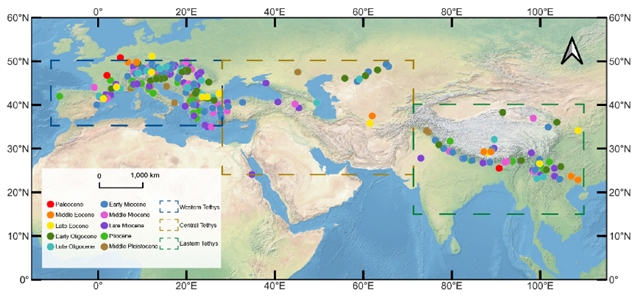
中国科学院西双版纳热带植物园李树峰团队近日研究了特提斯海地区新生代气候演化及其驱动因素。该研究于2025年5月20日发表在《中国科学:地球科学》杂志上。
特提斯海的海侵和回归深刻地影响了欧亚大陆的环境和生物多样性格局,并通过改变陆海分布和更广泛的水分输送方案对全球气候动力学产生影响。然而,结合化石资料和气候模拟来探讨特提斯海地区新生代气候演化的综合研究很少。
研究组对特提斯海地区363个地点的10个大型化石区系气候参数进行了重建,并与HadCM3模拟结果进行了比较。此外,他们还提出了一个结合降水和温度的地中海气候指数(MCI)来分析地中海气候的演变。结果表明,特提斯海地区的气候由古近纪的热带和亚热带气候逐渐转变为新近纪-第四纪的暖温带和寒温带气候。最冷月平均地面气温(CMMT)的分布格局由古近纪以地带性为主转变为新近纪以来在特提斯东部和中部受地形影响的分布格局。
特提斯海地区的降水模式表现出明显的波动。特提斯西部地区夏季降水变率增加,冬季降水略有减少。特提斯中部地区由于海退和山脉隆起而变得明显干燥。随着青藏高原的发展,特提斯东部地区夏季和冬季降水均显著增加。
始新世至渐新世早期,地中海气候在中亚和欧洲盛行,但在中新世期间,地中海气候的范围急剧缩小,主要原因是夏季降水减少。渐新世—早中新世是特提斯海地区气候演化的关键时期,其主要受陆海分布、地形演化和全球CO2浓度变化的影响。研究结果为探索新生代以来欧亚大陆气候变化驱动下的生态系统演化和物种多样性提供了重要参考。
附:英文原文
Title: Climate evolution and its driving factors in the Tethys Sea region during the Cenozoic
Author: Jiangbo MENG, Jiagang ZHAO, Linlin CHEN, Paul J. VALDES, Alex FARNSWORTH, Svetlana POPOVA, Mine Sezgül KAYSERI-ZER, Gaurav SRIVASTAVA, Jian HUANG, Tao SU, Zhekun ZHOU, Shufeng LI
Issue&Volume: 2025/05/20
Abstract: The transgression and regression of the Tethys Sea profoundly influenced the environment and biodiversity patterns of Eurasia, which had implications for global climate dynamics by altering the land-sea distribution and the broader moisture transport scheme. Despite its importance, few comprehensive studies have integrated fossil data and climate modeling to explore the climate evolution in the Tethys Sea region during the Cenozoic. In this paper, we reconstruct 10 climate parameters using macrofossil flora from 363 sites across the Tethys Sea region throughout the Cenozoic, and we compare these reconstructions with simulations from the Hadley Center Coupled Model (HadCM3). Additionally, we propose a new Mediterranean Climate Index (MCI), which combines precipitation and temperature, to analyze the evolution of the Mediterranean climate. Our results indicate that the climate in the Tethys Sea region gradually changed from predominantly tropical and subtropical conditions during the Paleogene to a warm temperate and cold temperate climate in the Neogene-Quaternary. The distribution pattern of the coldest month mean surface air temperature (CMMT) changed from a predominantly zonal pattern in the Paleogene to a topographically influenced distribution in the eastern and central Tethys regions since the Neogene. The precipitation patterns in the Tethys Sea region exhibited significant fluctuations. In the western Tethys region, the summer precipitation experienced increased variability, while the winter precipitation decreased slightly. The central Tethys region became significantly drier due to sea regression and mountain uplift. Both the summer and winter precipitation increased markedly in the eastern Tethys region with the development of the Tibetan Plateau. From the Eocene to the early Oligocene, the Mediterranean climate prevailed in Central Asia and Europe, but its extent contracted sharply during the Miocene, primarily due to the decrease in the summer precipitation. The Oligocene-Early Miocene was a critical period for climate evolution in the Tethys Sea region, which was driven by changes in the land-sea distribution, topographic evolution, and global CO2 concentration. The results of this study provide a crucial reference for exploring the evolution of ecosystems and species diversity in Eurasia driven by climate change since the Cenozoic.
DOI: 10.1007/s11430-024-1561-y
Source: https://www.sciengine.com/SCES/doi/10.1007/s11430-024-1561-y
Science China Earth Sciences:《中国科学:地球科学》,创刊于1952年。隶属于施普林格·自然出版集团,最新IF:5.7
官方网址:https://www.sciengine.com/SCES/home
投稿链接:https://mc03.manuscriptcentral.com/sces
